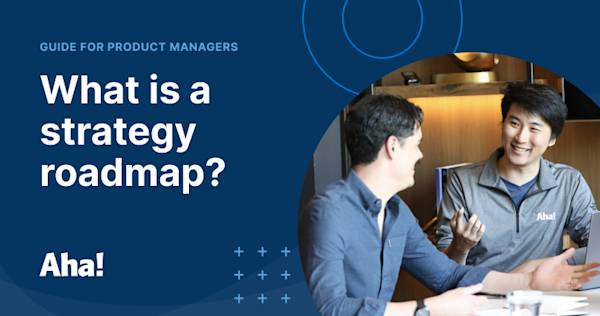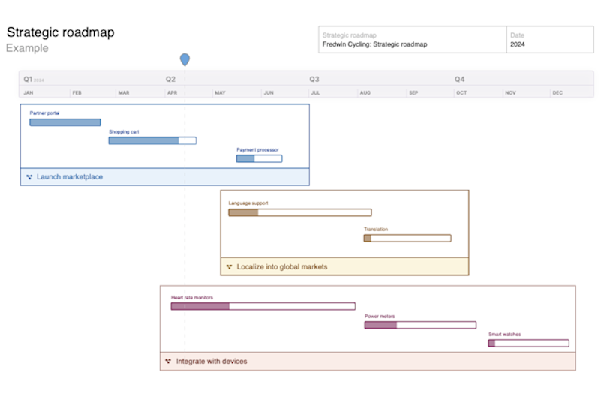The Aha! Framework for product development
Our proven model for delivering products that customers love
Updated: September 2025
The Aha! Framework is a flexible product development process. It gives product teams a way to set strategy, prioritize work, and achieve quickly — balancing long-term planning with agile delivery. Use this guide to explore the full methodology and the activities in each stage. |
The Aha! Framework for product development promotes a strategic approach to agile work. It is a flexible model that product organizations can leverage to improve efficiency and increase value delivered to customers.
The Aha! Framework ensures prescribed biannual strategic alignment while supporting ongoing sprints with continuous deployment. That is what makes it unique. We developed and have used the framework for more than a decade — it continues to power our product success.
Our goal when we founded Aha! in 2013 was to help organizations set clear strategy and connect it to the work of building products that customers love. We pioneered a new category with our first and now flagship product, Aha! Roadmaps. And our software currently serves more than 1 million product builders at many of the world’s most innovative and well-known companies. (If you have not yet tried Aha! software, you can start a free 30-day trial.)
But we did not explicitly share our own product development methodology for many years. So let's get into the details of The Aha! Framework. The content below is organized logically for folks who are new to the method. If you know what you are most interested in, you can also jump ahead to any section:
Why standardize work with a product development methodology?
What are the pros and cons of current product development methodologies?
Why a strategic approach to product development is better for most teams
Why standardize work with a product development methodology?
Before we get into what we believe is the best way to develop products, it is worth reviewing why you need a way to do so at all. Remember that breakthroughs are rare. And despite the mythologies that exist about flashes of insight or “eureka” discoveries, real innovation is almost always the result of careful research and planning. You choose a product development methodology because it gives people a process for achieving repeatable success.
Product development is complex. The process of setting strategy, discovering what customers want, brainstorming, planning, building, releasing a product to market, and measuring its success is inherently fraught with hurdles. Myriad teams and stakeholders provide insights and produce results. It is a collective effort that requires close collaboration and tight coordination.
Now, there is no doubt that it is hard to align groups of people on how they should work. Adopting a new methodology is a major investment for any organization. Very few companies adopt one before building anything — so you have the added challenge of integrating the new way of working with in-progress projects and entrenched habits. This kind of shift represents a significant collective effort, one which often requires education and reskilling for teammates. But the reward should outweigh the effort and any pain along the way.
What are the pros and cons of current product development methodologies?
The amount of software being developed today is staggering. So it is somewhat surprising that there are just a handful of named product development methodologies used by the majority of teams.
We can divide these methods into two groups: sequential (waterfall) and iterative (agile). The majority of the frameworks you are likely familiar with fall into the latter category. Agile is not a prescribed technique, but rather a term used to refer to certain values and a mindset.
For the sake of brevity, we will focus on the most common approaches that we know product development teams use: kanban, Scaled Agile Framework® (SAFe®), scrum, and waterfall. The table below is in alphabetical order and provides a basic description of each method along with pros and cons.
Methodology | Pros | Cons |
Kanban Kanban is a workflow management system that helps agile software development and product teams define and manage work and continuously improve performance. Each card on a kanban board represents a work item. A team's kanban board is always in motion, and new cards are pulled from the backlog and added to in-progress work as team capacity allows. Related: What is kanban? |
|
|
SAFe® SAFe is a comprehensive set of guidelines for implementing agile and lean principles at scale. The framework was developed and launched by Scaled Agile Inc. in 2011. SAFe puts forth a set of values and principles that can be applied across the different levels of an enterprise, from individual teams to broad portfolios. |
|
|
Scrum Scrum is one of the most popular agile frameworks. Founded on empiricism, scrum relies on self-managing teams working collectively to consistently deliver value at a sustainable pace. Scrum is organized around a set of theories, values, and practices. Scrum teams have no imposed hierarchy within the group, with just two defined roles of scrum master and product owner. Related: What is scrum? |
|
|
Waterfall Waterfall is a sequential model for planning, building, and delivering new products and features. Each phase of development must be documented and approved before the next phase can begin. There are no defined theories, values, roles, or ceremonies in waterfall. The focus on logical progression of steps completed sequentially is meant to ensure projects are completed within budget and on time. |
|
|
Why a strategic approach to product development is better for most teams
Almost everyone today dismisses sequential waterfall approaches as too outdated and rigid for software development. Agile methods are celebrated because there is an assurance of total flexibility, with more control given to the people doing the work. However, teams often get lost in agile because there are no clear strategic goals and initiatives to guide that work. This lack of structure can lead to moving quickly — yet not building what will actually create the most value.
So folks seek out methods that promise the speed of agile with the predictability and goal-first focus of waterfall. Some end up with painstakingly complex methodologies where the process becomes the work. Others cobble together a homegrown approach that leverages legacy workflows with agile practices awkwardly layered on top. Neither one is ideal nor conducive to developing lovable products.
After working with hundreds of product development teams, we can confidently let you in on a little secret — no one is strictly adhering to any of these methodologies. (Yes, that includes SAFe.)
Most product leaders bemoan the struggles of trying to get the team to follow a specific methodology. The main complaint is that ultimately, the organization does not ship as quickly as it would like and on a cadence that benefits customers.
But there are other consistent themes:
There is no strategic alignment.
It is difficult to uncover and implement customer insights.
Processes are not clearly documented.
The team does not fully embrace the process.
Different groups work differently.
There is too much bureaucracy.
Too much time is spent in meetings talking about work vs. just doing it.
Transparency into team efficiency and value created is impossible.
The reality is that most folks benefit from an agile-ish approach that is grounded in strategy. You need defined goals to work toward, clear processes and work ownership, the flexibility to improve over time, and the responsibility to measure the value of what you deliver.
This is what we have done at Aha! for a long time. We borrowed areas of strength from different existing methods while leaving the challenges behind.
What is The Aha! Framework for product development?
The Aha! Framework for product development is the engine that has powered our success for the last 10+ years. It is core to our company’s growth and position as market leader for product development software.
Our success hinges on our commitment to building what customers actually value, and doing it fast. The Aha! team ships enhancements and new features that customers value daily. It also delivers uber-responsive support, with around-the-clock guidance delivered in typically less than two hours.
We achieved this by pioneering a new concept in 2013: Minimum Lovable Product (MLP). The MLP is a rebuttal to the minimum viable product (MVP). We believe the MLP is superior, as the MVP puts emphasis on building only what is viable (or what people will tolerate) rather than what will inspire love.
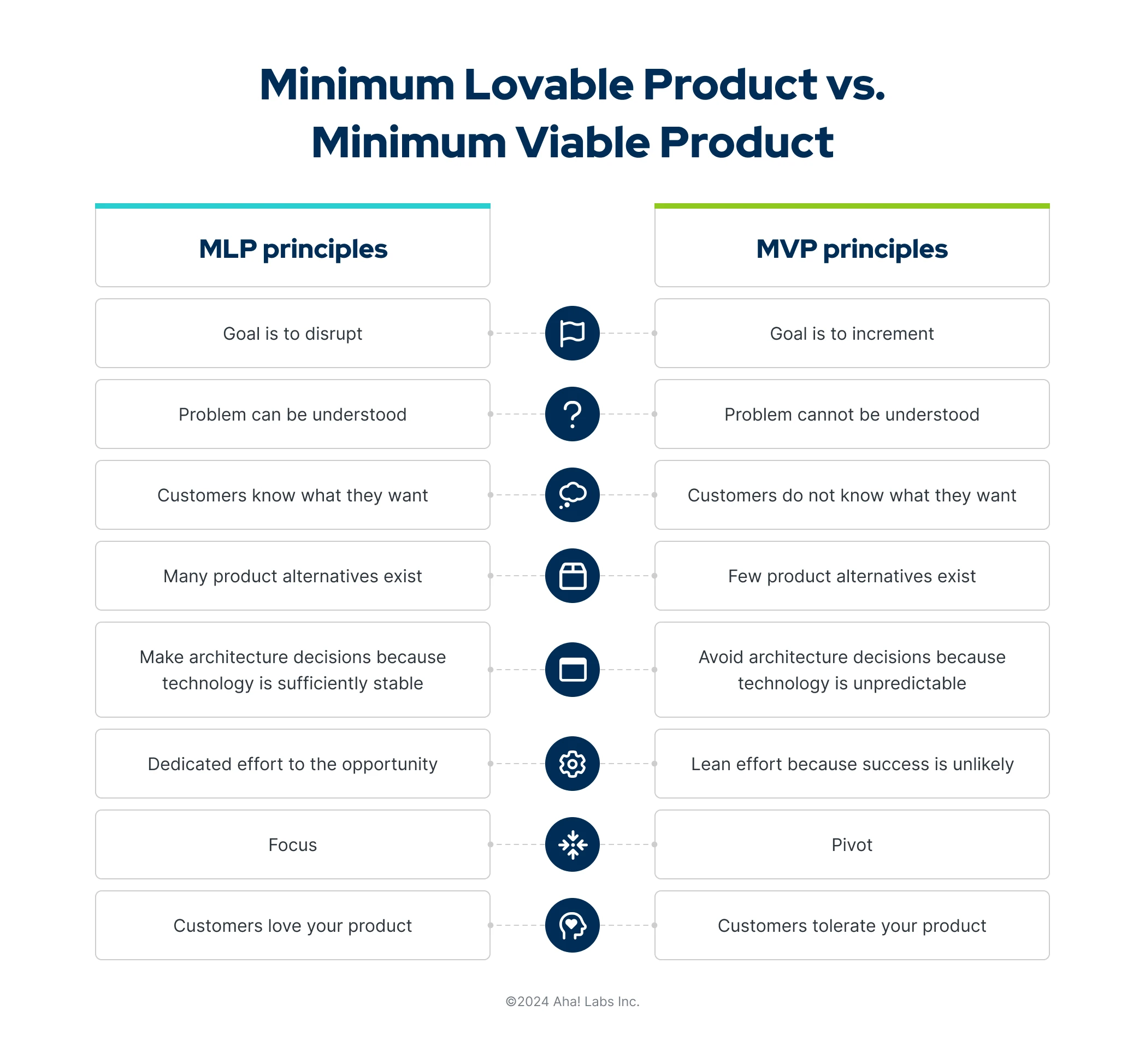
A year after introducing MLP, we codified a framework for personal and business success. The Responsive Method (TRM) is centered around the belief that interactions with urgency propel people and organizations forward. Our perspective was further expanded upon in Aha! co-founder and CEO Brian de Haaff's bestselling 2017 book, Lovability.
Company leaders frequently come to us interested in bringing the Aha! value-first product development approach to their teams. These folks often use a workflow or methodology that is designed for predictability, but does not deliver the value they hoped for. They are looking for a better way forward — and ask how we approach product development.
We have always been willing to share our guidance and knowledge so others can benefit. Documenting product development resources was something we began doing early on in the company's history. Since then, we have published hundreds of blog posts along with a comprehensive guide for product managers on the Aha! website.
The Aha! Framework is a defined and proven model for product development. The goal is to deliver an MLP. The framework blends upfront strategic planning with the rapid delivery of agile, putting an emphasis on value creation. This approach was integral to the successful development of all products in the Aha! suite: Aha! Roadmaps, Aha! Discovery, Aha! Ideas, Aha! Whiteboards, Aha! Knowledge, and Aha! Develop.
We know that The Aha! Framework for product development works. And we know that many product teams are looking for a better way to plan, build, and launch products that customers love. So we are sharing the complete framework, both in this guide and directly in Aha! Roadmaps with dedicated functionality that teams can use to define how they work.
What are the activities in The Aha! Framework?
The Aha! Framework is organized around what we have defined as the 10 core stages of product development. Within each stage, there are discrete activities that support positive progress throughout the product development process. It starts with biannual strategic alignment and includes ongoing delivery.
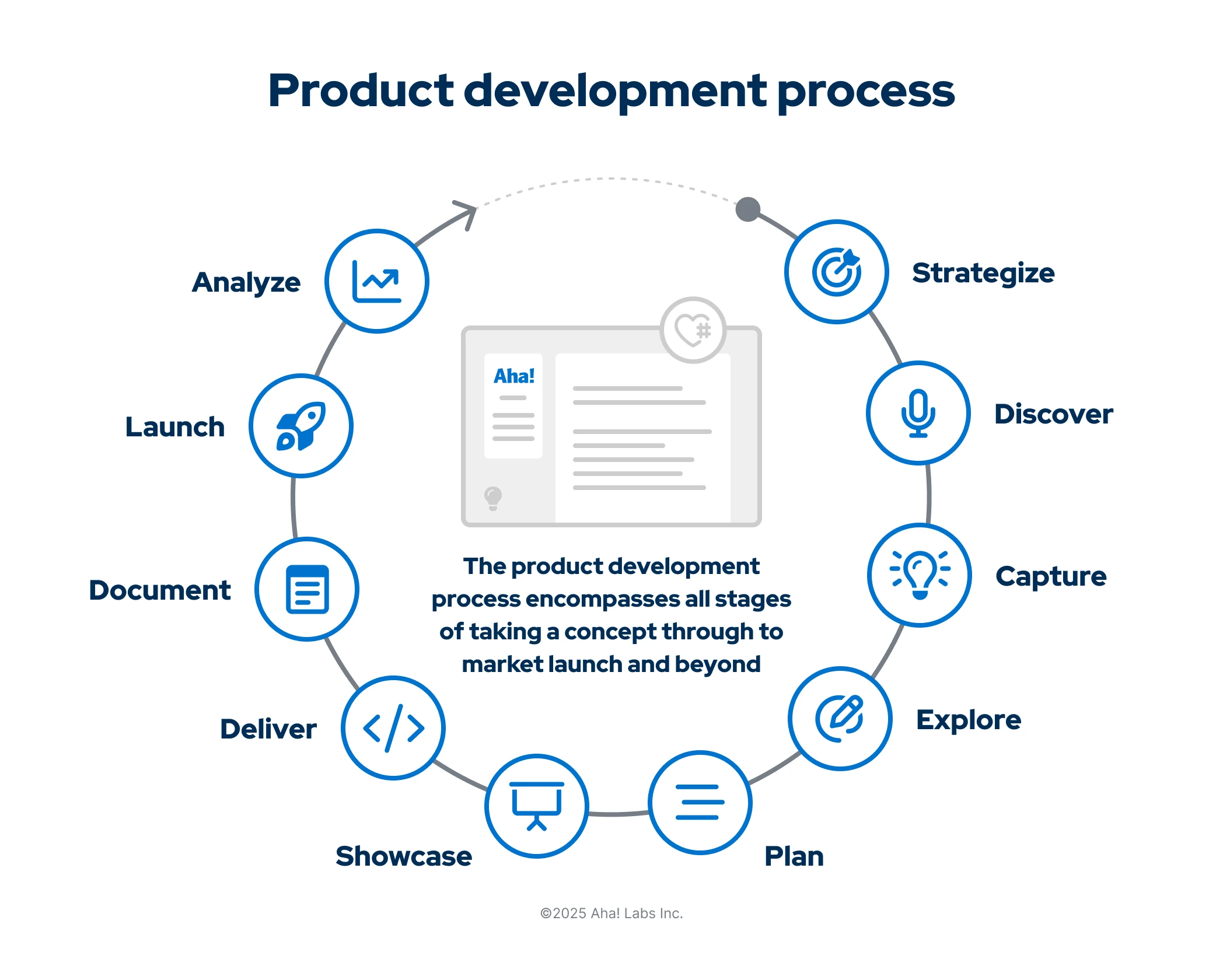
The activities in The Aha! Framework are presented sequentially, but many repeat frequently to support continuous improvement. The time frame for how often an activity occurs is dependent on your organization and product development cycle.
If you use Aha! Roadmaps, you can view the entire framework, define your own best practices, and link to where the work should be completed with our Frameworks functionality. Or, if you simply want to explore this methodology on a whiteboard, you can try The Aha! Framework template.
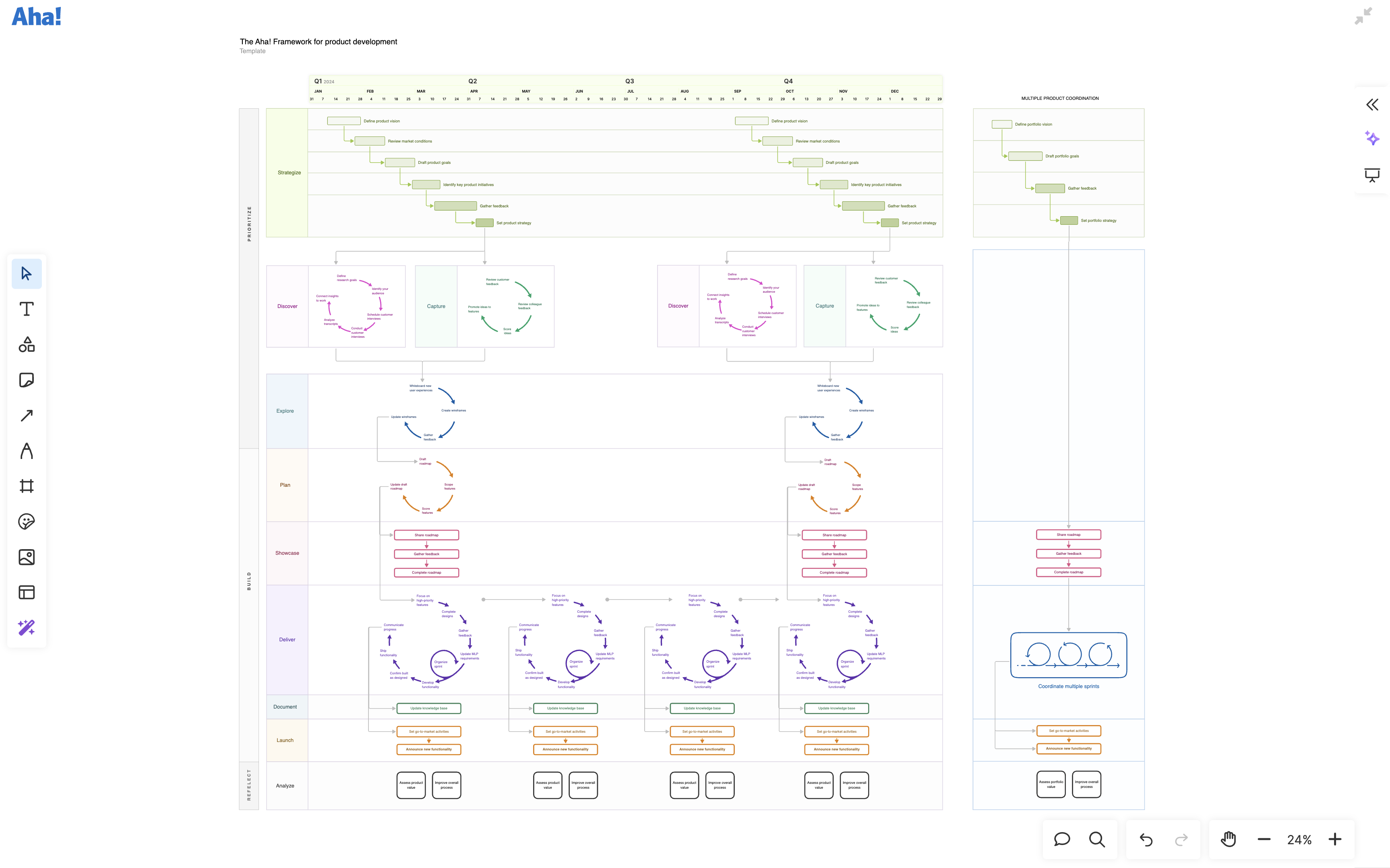
Related:
The table below shows the activities within each stage (using the time frames that we follow at Aha!) along with a brief description of what you and the team will be doing. If you manage several interconnected products, there is additional information at the end of the table that shows how you can apply The Aha! Framework to a portfolio.
Stage 1: Strategize | ||
Define product vision | Establish your worldview. This provides clarity about what you want to achieve as a team and how you are going to get there. This is also a good time to get clear on your product positioning and the unique value your offering provides. | Frequency: Semiannually |
Review market conditions | Identify any shifts in the market that impact your company and product. Then, update your business model, target personas, and competitor profiles as needed. Use this research to inform your product strategy. | Frequency: Semiannually |
Draft product goals | Understand your overarching company goals. Then, draft product goals that contribute directly to your organization's success and help you realize your vision. Objectives should be ambitious, measurable, and time bound. | Frequency: Semiannually |
Identify key product initiatives | Consider the key strategic initiatives or major themes of work you want to invest in to achieve your goals. This bridges your high-level strategy to the actual work the team will implement to achieve it. | Frequency: Semiannually |
Gather feedback | Share the draft of your goals and initiatives with leadership and other key stakeholders. This ensures everyone is aligned on the "why" behind your roadmap before you get deeper into planning. | Frequency: Semiannually |
Set product strategy | Give the team a true north to follow. Solidify your goals and initiatives — showing how they tie together — so everyone understands the overarching plan for how you will achieve your product vision. | Frequency: Semiannually |
Stage 2: Discover | ||
Define research goals | Capture key product discovery assumptions and objectives for your research study. Focus your efforts and ensure you gather relevant insights. | Frequency: Weekly |
Identify your audience | Determine which customers or users you need to interview to gain the most valuable insights from your research. | Frequency: Weekly |
Schedule customer interviews | Define outreach emails and invite research participants to meet with you. Draft discussion topics and script a set of questions that will help secure the answers you need. | Frequency: Weekly |
Conduct customer interviews | Engage in discussions with customers to gather information about their challenges, needs, and aspirations. | Frequency: Weekly |
Analyze transcripts | Review interview videos and transcripts to uncover key quotes, sentiments, and insights that will inform product strategy and roadmap decisions. | Frequency: Weekly |
Connect insights to work | Link your insights directly to initiatives, ideas, and features to guide them and ensure they are customer-driven. | Frequency: Weekly |
Stage 3: Capture | ||
Review customer feedback | Understand what matters most to your customers. Identify key themes across the feedback customers proactively submitted to your ideas portal (and other channels) to identify opportunities for improvement. | Frequency: Weekly |
Review colleague feedback | Gather different perspectives. Ask internal teams — such as marketing, sales, and support — to share their ideas on how to best serve your customers' needs. This gives everyone a chance to weigh in and broadens your thinking. | Frequency: Weekly |
Score ideas | Find the ideas that will bring the most value to both customers and the business. Score each idea based on potential product value. Additionally, consider how well each idea supports your strategic initiatives and the effort it will take to implement. | Frequency: Weekly |
Promote ideas to features | Review the top ideas with stakeholders and get input on their biggest priorities. Understand the ideas that will generate the highest revenue and deliver the most delight. Then, turn those highly impactful ideas into features on your roadmap to schedule them for implementation. | Frequency: Weekly |
Stage 4: Explore | ||
Whiteboard new user experiences | Explore possibilities based on prioritized ideas. Think through innovative ways to solve customer problems and define the ideal user experience. Challenge assumptions and push everyone's thinking to reimagine the future. | Frequency: Weekly |
Create wireframes | Wireframe possible solutions early in the planning process. This gets everyone thinking about the desired solution and what it will take to implement to further inform your roadmap. | Frequency: Weekly |
Gather feedback | Share your early concepts with stakeholders to gather different perspectives on the best approach. | Frequency: Weekly |
Update wireframes | Refine your ideas based on stakeholder feedback and new learnings. These wireframes will be used to inform more detailed designs once the actual work is about to start. | Frequency: Weekly |
Stage 5: Plan | ||
Map out a high-level plan for what you want to deliver and when. Create a prioritized list of features and lay them out on a visual timeline to think through sequencing and target delivery dates. | Frequency: Quarterly | |
Scope features | Capture key details about each feature based on what the end user needs to accomplish. Collaborate with engineering to identify any major technical requirements and capture an initial estimate. This ensures everyone is clear on the scope. | Frequency: Weekly |
Score features | Update the product value score for each feature based on new learnings about its scope and effort. Then, rank features in priority order to make it easy to determine what to build next. | Frequency: Weekly |
Update draft roadmap | Refine your initial roadmap. Adjust the sequencing, duration, and target delivery dates of your prioritized features. Define releases to explain at a high level when new functionality might be delivered. Of course, you will need to continually adapt your plans based on new customer insights, learnings, and progress. | Frequency: Weekly |
Stage 6: Showcase | ||
Share roadmap | Share your roadmap with stakeholders. It is important to give strategic context about what you want to accomplish. Explain the trade-off decisions you had to make and why to get everyone on board before you finalize your plan. | Frequency: Monthly |
Gather feedback | Set up review meetings to discuss your roadmap with stakeholders. This gives everyone the opportunity to share their perspectives on what you have planned or what might be missing. | Frequency: Monthly |
Complete roadmap | Make any final adjustments. Then, share the updated version to close the feedback loop. This does not mean you are done, though — keep stakeholders informed as plans evolve and progress happens. | Frequency: Monthly |
Stage 7: Deliver | ||
Focus on high-priority features | Start with the features that have the highest score. Update feature definitions to include the Minimum Lovable Product (MLP) requirements — capturing what is needed for customers to love (and not just like) what you deliver. | Frequency: Weekly |
Complete designs | Finish up designs to show how new functionality will work. This will ultimately serve as inspiration that guides the engineering team on what needs to be delivered. | Frequency: Weekly |
Gather feedback | Get input on designs from teammates and stakeholders. Check with IT and operations for any concerns about supporting the new solution. This is also a good opportunity to talk with customers and get early feedback on the proposed solution. | Frequency: Weekly |
Update MLP requirements | Ready the requirements for development. Finalize everything based on feedback and learnings from the design review. Then, send the details to engineering to bring new functionality to life. | Frequency: Weekly |
Use sprints as a way to group work for implementation. Sprints should be in your development tool and contained within a release. If you prefer a kanban approach, that can work too. Remind yourself at regular intervals to confirm that your list of priorities is still aligned with the overall product goals. | Frequency: Weekly (or biweekly) | |
Develop functionality | Partner closely with the development team to build the MLP version of the feature. The goal is to deliver value fast and keep iterating based on customer feedback. | Frequency: Weekly |
Confirm built as designed | Ensure that you are delivering what customers will love. Engage the core product team — product management, UX, and engineering — to give the final sign-off. | Frequency: Weekly |
Ship functionality | Prepare for launch. Deliver the functionality to production for all customers or behind a feature flag. | Frequency: Weekly |
Communicate progress | Keep stakeholders informed of progress as you deliver against your roadmap. Be transparent about priority changes and delivery risks that might impact dates — so teams such as operations, IT, and marketing can adjust their rollout plans. This ensures that there are no unexpected surprises and keeps everyone in sync. | Frequency: Weekly |
Stage 8: Document | ||
Update knowledge base | Ensure customers and cross-functional teammates get the most benefit from what you built. Publish user guides, FAQs, and best practices on how to successfully configure and use the new functionality. | Frequency: Weekly |
Stage 9: Launch | ||
Prepare the cross-functional team for launch. Set up a kickoff call to align on a launch date. Define positioning to help marketing effectively communicate the value of the new functionality. | Frequency: Weekly | |
Announce new functionality | Share the exciting new functionality with the world. Communicate the news to prospective and existing customers via different channels to drive awareness and adoption. | Frequency: Weekly |
Stage 10: Analyze | ||
Assess product value | Be accountable for your strategy. Measure the actual value created against what you projected early on in the planning process. Track key product and feature adoption metrics to understand whether you achieved your goals. | Frequency: Weekly |
Improve overall process | Keep raising the standard. Take time with the team to look back and identify what went well and what could have been improved. Use what you learned to make adjustments so you can maximize productivity for the next iteration. | Frequency: Weekly |
How does the framework work for multiple products?
Many companies simultaneously build and support several interconnected products. The Aha! Framework is ideal for managing product development for a single product and can also be used for many products that have coordinated releases.
Using The Aha! Framework to manage a portfolio requires slight adjustments within five of the 10 product development stages:
Stage 1 (Strategize): Set strategy at the portfolio level, establishing the high-level direction for the products and solutions you offer.
Stage 2 (Discover): Bring all customers into a single research database, but separate audience segments for different products or research studies.
Stage 6 (Showcase): After you create individual product roadmaps, create a portfolio roadmap to bring together the various release plans.
Stage 7 (Deliver): Coordinate multiple sprints so you can build, deploy, and support new functionality or experiences across the portfolio in a synchronized way.
Stage 9 (Launch): Capture go-to-market activities across the portfolio to coordinate launches across multiple products and teams.
Stage 10 (Analyze): Be accountable for your portfolio strategy, measuring collective value delivered and identifying improvements.
If you are interested in learning more about The Aha! Framework, start a trial of Aha! Roadmaps or reach out to our team. We respond super fast.
